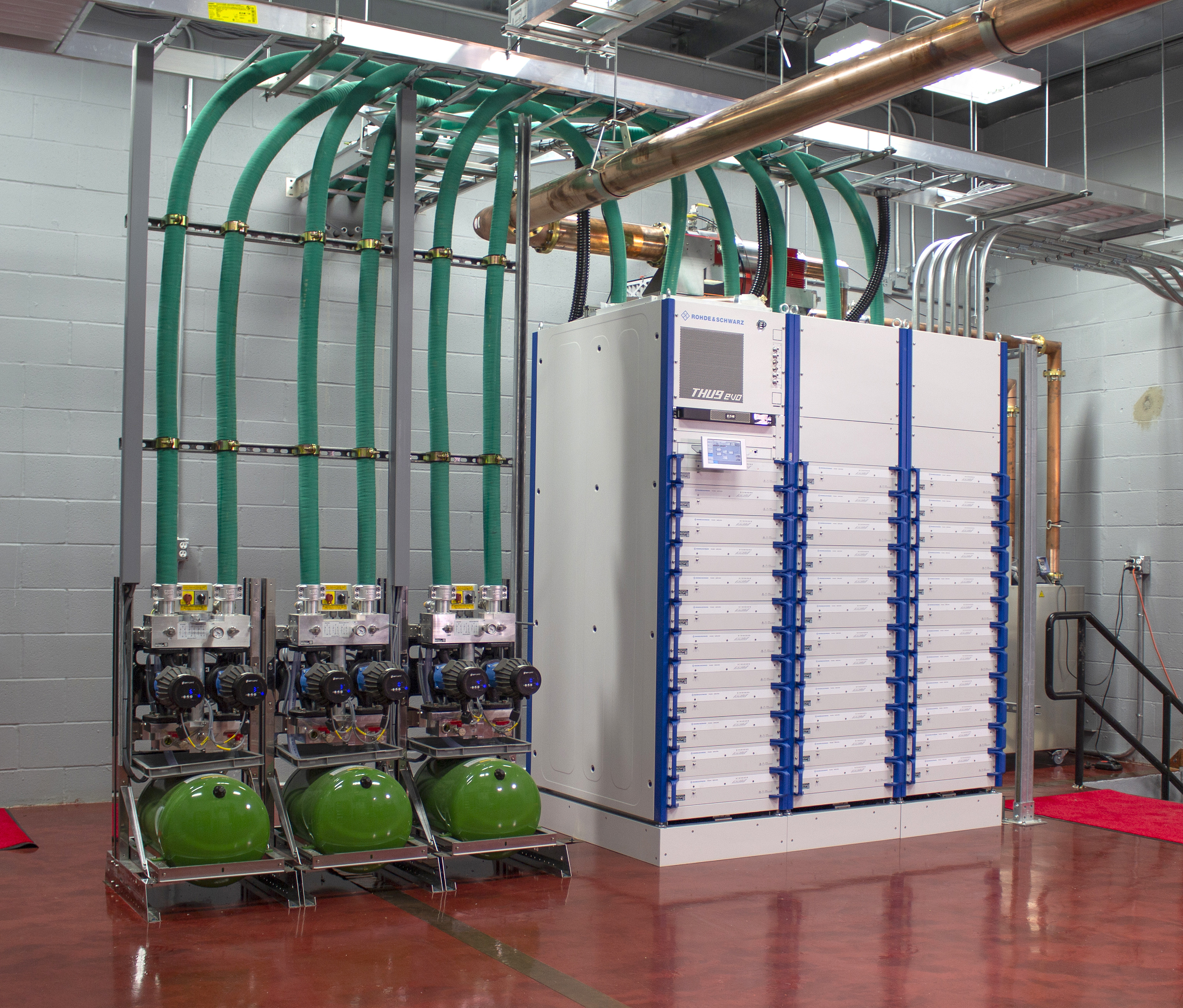Repack Begins, Deadlines Tight
ALEXANDRIA, VA.—The Great TV Channel Auction and Repack is now underway, with television and FM radio broadcasters doing the necessary work to change frequency assignments and install new equipment. It is a lot of work, but progress is being made daily.
In addition to the repack project work now underway, the FCC is currently asking for comments about the repack process and reimbursement for affected Class A stations, low-power TV stations, translators and FM broadcasters; deadline is Oct. 26. In addition to the full-power repack, as many as 1,000 smaller stations are being moved in 10 phases, which will cause dislocation and incur some expenses for LPTVs and translators that were not protected in the repack. This also affects some FM stations colocated on TV towers.

In the event you’ve been lost in space for the past two years, the Channel Auction and Repack exists to shift TV broadcasters to VHF and lower-UHF channels, with the goal of freeing up spectrum for wireless services for mobile devices. A distant model was the BAS Relocation program from 2005 to 2010, which also had broadcasters giving up a slice of spectrum for the benefit of a cellphone company.
Since the process began in the spring of 2017 after a spectrum auction that yielded approximately $20 billion to the federal government, more than 120 full power and Class A television stations have moved off their pre-auction channels, according to Jean Kiddoo, chair of the FCC’s Incentive Auction Task Force.
“Approximately half of those stations chose to move before the first formal transition deadline,” she said. “The other half consists of stations that won incentive payments during the auction but elected to continue broadcasting by sharing a channel with another station, and have now implemented those channel-sharing agreements.”
NOW UNDERWAY
By the time you read this article, the first formal phase of the Channel Auction and Repack is now underway. Kiddoo said that the testing period for Phase 1 of the repack began Sept. 14 and ends Nov. 30. There are 82 full-power and Class A television stations scheduled to transition during Phase 1.
The professional video industry's #1 source for news, trends and product and tech information. Sign up below.
[Read: Transitioning To New Channels—Phase 1 Deadline Looms]
Obviously, re-assigning channels of TV broadcasters and radio stations is an expensive proposition, fraught with complex engineering challenges as well as concern about changes in propagation and coverage. Congress appropriated funds to pay for this work, and broadcasters have been receiving reimbursement.
“The initial reimbursement fund totaled $1.75 billion, and as of April 16, 2018, virtually all of that [$1.742 billion] has been allocated by the FCC,” Kiddoo said. “That represents 92.5-percent of total estimates for each station. “Stations have been able to draw down against their allocation by submitting invoices for eligible costs incurred since October 6, 2017.”
As for the remaining 7.5-percent of the projected costs and additional expenses, it appears to be on the way.
“Congress provided additional funding in the 2018 Omnibus Appropriations Act to reimburse reasonable costs incurred by full power and Class A broadcasters as well as previously-ineligible LPTV/TV translator and FM stations,” Kiddoo said. “The rulemaking to adopt rules and procedures to reimburse the latter is anticipated to be completed in the first quarter of 2019.”
How does this translate to the real world of actual broadcasters going through the repack work? Dale Scherbring, a regional director of engineering for Sinclair Broadcast Group and the company’s repack manager, said the project is keeping him busy.

“The Sinclair Broadcast Group’s engineering team has been working on 100 repacks for the company-owned stations and fulfilling contracts with our partner stations,” Scherbring said. “Phase 0 stations and one Phase 1 station have made the transition and are on the air.”
Phase 0 stations on the air include:
- WCHS (Charleston, W.Va.)
- WDSI (Chattanooga, Tenn.)
- WICD (Champaign, Ill.)
- WNUV (Baltimore, Md.)
The only Phase 1 station moved so far is KJZZ (Salt Lake City).
Scherbring said that the company’s Phase 1 stations currently in progress for repack work are:
- KBTV (Beaumont, Texas)
- KFDM (Beaumont, Texas)
- KMEG (Sioux City, Iowa)
- KPTH (Sioux City, Iowa)
- KMPH-CD (Fresno Calif.)
- KRXI (Reno, Nev.)
- WNWO (Toledo, Ohio)
“The remaining 88 stations are in various stages of equipment order, tower studies and overall planning,” he said.
MASSIVE SCOPE
There has been a lot of discussion about the massive scope of this project versus the relatively small size of the broadcast equipment manufacturing industry. In other words, would the manufacturers of transmitters, antennas and ancillary components be able to build high-quality and reliable equipment for the repack in the relatively short time frame for which the project is scheduled? Then, will there be sufficient crews to properly install it?
“The overall planning for our projects is showing no major issues,” Scherbring said. “The implementation of some projects is running into major weather delays for the tower crews, some vendor-delayed shipping issues, and in some cities major delays with local zoning permits.”

The NAB keeps its eye on the big picture across the country. Dennis Wharton, executive vice president of communications for the NAB, said that he is giving special attention to project timing—especially in the latter stages of the work.
“We remain concerned that the 39-month timeframe created by the FCC is simply insufficient to accommodate all the stations that have to be moved,” Wharton said. “It’s going to be especially difficult for stations in later phases that may not have already contracted for repack work. The tragic loss of four talented tall-tower workers reduced an already small pool of qualified tower dogs. In addition, the first couple phases have fairly long transition periods—132 days in the case of Phase 2. However, Phases 3 and beyond are very compressed—just 34 days in Phase 5—and any unexpected delays will affect scheduling like a stack of dominoes.”
Wharton also noted that many stations are linked with one or more other stations and cannot transition until those other stations have also transitioned. And due to cold weather and dangerous weather conditions, there are only so many months of the year that tower work is feasible in the northern states.
NEXT GEN TV
In the past couple of years, there has been a lot of discussion of ATSC 3.0 and Next Gen TV, and stations across the country are keeping this in mind now that repack work is upon them.
“I believe many stations being repacked will upgrade to equipment that can more easily transition to Next Gen TV,” Wharton said. “Some of this new equipment can move from the current standard to Next Gen TV transmission with the flip of a switch, so it does present an opportunity for stations to upgrade for the future.”
Sinclair Broadcast Group has been a avid proponent of ATSC 3.0, so the question came up as to what the company might be doing for the repack to prepare for an ATSC 3.0 future.
“Sinclair has maximized stations’ signal reach and included some vertical polarization elements in all the new antennas that are being purchased,” Scherbring said. “This will enhance ATSC 3.0 [operations], but the costs of these items are not reimbursable, so they are an extra cost to each station.”
STILL NOT CLEAR
There’s no question that the channel auction and repack is big—really big. In addition to the repack at full-power stations (which is fairly well known and documented), the FCC said that the number of affected low-power, translators and FM broadcasters is still not clear.
“We do not yet know how many FM or LPTV and translator stations will be affected by the repack,” the FCC’s Kiddoo said. “To date, construction permits for more than 1,500 of the roughly 2,100 LPTV/translator stations that filed applications in the special displacement window have been granted. The Notice of Proposed Rulemaking that the commission adopted in early August sought comment on eligibility requirements and reimbursement procedures for those FM and LPTV/translator stations that incur costs as a result of the repack.”
Therefore, it remains to be seen exactly what the costs and time schedule will be to complete all repack work. In the meantime, work is proceeding quickly across the country.
When asked if the repack was a good thing or just another regulatory nuisance, one broadcaster replied philosophically.
“We can all be armchair quarterbacks on Monday morning,” Sinclair’s Scherbring said. “These are the new rules we broadcasters must live with—we will make it happen.”
For all the latest news and insight on the repack, visit our repack silo.
Bob Kovacs is the former Technology Editor for TV Tech and editor of Government Video. He is a long-time video engineer and writer, who now works as a video producer for a government agency. In 2020, Kovacs won several awards as the editor and co-producer of the short film "Rendezvous."

